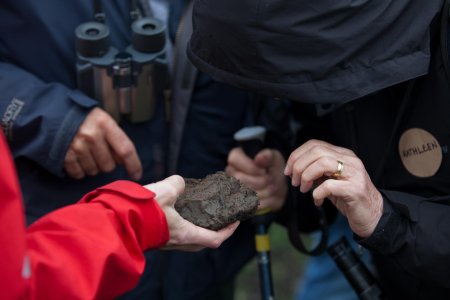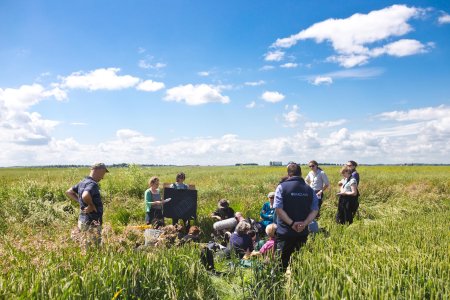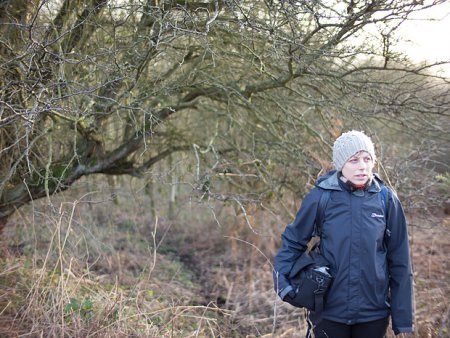A Field of Wheat by Ruth Levene

On the site of drained fen land in Branston Booths, Lincolnshire, UK sits a 9 ha piece of land: officially named 'Middle Field', it is one of three fields belonging to farmer Peter Lundgren. In September 2015, Middle Field became the focus of a year-long participatory artwork entitled A Field of Wheat.
In a collaboration between artists Anne-Marie Culhane and myself, working with Lundgren, we recruited a collective of 42 people, including the head of agriculture from Barclays Bank and their land agency advisor, a local baker, a dancer, an architect and his family, local Quakers, a food systems expert, a heritage wheat grower, a member of the local Council, a crop researcher and academics, all of whom invested £200 (about $250) in the wheat that was still to be sown. From drilling the wheat in October 2015 to harvesting in August 2016, the collective took part in a series of events, talks, activities and discussions: on the farm, in the city of London, in a Quaker meeting house and on a dedicated online platform.
The concept was to go on a journey together to understand, question, make decisions and reflect on the complexities of modern wheat farming, unravelling its networks and impacts within a global context. Through bringing different perspectives together we would take a closer look at Middle Field, its history, its health, its economics and its culture, and so reflect on farming in general amid the challenges of climate change, resource depletion and economic growth.
Water is a central subject when telling the story of wheat farming on drained fen lands. The day the collective, farmer and artists first met and stood in the field, the healthy green shoots poked only a few inches above the dark wet soil. Tom Lane, a local archaeologist and folklorist, pointed out the barely visible undulations that indicated the area’s history as a network of creeks and meandering tributaries of the River Witham. As we all clustered around a laminated LIDAR map of the area, he explained that our field had a number of different soil qualities related to the underlying deposits of silt and alluvium.
We held this shifting history of the field in our hands: dark fenland peat, formed when the fens were flooded marshes, sticky clay soils deposited by ancient tidal rivers and a lighter silty soil that marked networks of slow moving creeks. Peter the farmer noted that these ancient river patterns also influenced the quality and growth of the crop across the field.

Prior to drainage, the undrained fens in Lincolnshire held a rich and complex life and ecology: 'Fen Slodgers' were the fen dwellers of those times, described as “half amphibious beings who got their living by fishing and fowling”. William Henry Wheeler in his book ‘A History of the Fens of South Lincolnshire’ (1896) goes on to describe them as “liv[ing] in huts, erected on the mounds scattered amongst the chain of lakes which were bordered with a thick crop of reeds, their only way of access to one another and of communication with the towns and villages near, being by small boats or canoes, which they paddled along with a pole, and also used in their fishing and fowling expeditions. The fen was their native land, such as it was and their only source of subsistence, precious though it might be”.
In our project, equal value was placed upon experiencing, doing, being and sensing Middle Field and its history as upon learning through facts. The collective’s members were invited to fling themselves over the cross drain that divides the field in two, as once a fenlander would have leaped it on his way to check his fish traps, bring in the eels, or perhaps attend a service at the church. We learned that this innovative form of navigation eventually became the olympic sport of pole vaulting.
Sitting at that same cross drain six months later, with the sun beating down and the wheat up to our hips, we had shifted our thoughts to the present. A far cry from its wetland past, this heavily managed landscape now has buried plastic 'land drains' crossing the field every 40 metres to keep the water table below the surface, just enough so the roots of the crop can still reach it, whatever the rainfall has been in any particular week.
The present-day story of Middle Field’s water is one of technology, engineering and management, in which the water is buried, pumped, drained, treated, polluted, hidden and diverted. We followed the water’s journey out of the field; through the rivers and to the sea. We also followed the pollution that goes with it, such as the Metaldehyde from pellets used to protect the crop from slugs, or the nitrogen fertiliser used to increase the yield. Following the journey of water beyond Middle Field exposed the wider costs and impacts of decisions made at the site. Life in the drainage channels and rivers (and the quality of the water we drink) depends on what we choose to put on our crops.
In the end we harvested almost 80 tonnes of wheat, which went to feed chickens and to make biscuit flour. We each made a profit of £11 (about $14) on our investment. The farming system we discovered is one that is shaped by rain and sun, and where the health of the crop, yield and profit competes with the health of the life in the soil, the margins and the surrounding waters.

By Ruth Levene
Ruth Levene is an artist based in Sheffield, South Yorkshire. She has been working alongside academic engineers and social scientists at the University of Sheffield, to make new artwork which explores and reveals water systems and cycles. The work manifests as maps, walks, video and photography and socially engaged work. She began collaborating with Anne-Marie Culhane in 2010 and went on to create A Field of Wheat in 2015. For more, see www.fieldofwheat.co.uk.